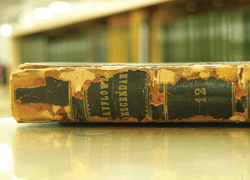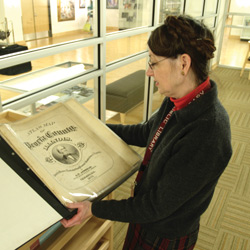Hunting for ancestors got easier last June when the Peoria Public Library opened its new Local History and Genealogy Department.
Library reference assistant Linda Aylward knows these books. On an afternoon tour of the Peoria Public Library’s new Local History and Genealogy Department, we drift through rows of the local history collection, pausing occasionally to skim noteworthy editions. She gingerly takes a volume off the shelf, supporting its ancient spine as she turns the pages. Her finger runs down a list of passenger names in Illinois Mayflower Descendents; in another, she traces a column of late 19th-century dates in an index entitled Germans to America: Lists of Passengers Arriving to U.S. Ports.
In this manner, we continue through the collection: books by Peoria and Illinois native authors, biographies of local personalities, local cookbooks and history books, annual budgets, school board minutes, city directories, manuscripts, maps and atlases. Donated materials from the Peoria County Genealogical Society and other organizations make up a large portion of the library’s hard-copy masses, along with indices of cemeteries, funeral homes, marriage records, obituaries, local and regional periodicals, county newsletters, and subscriptions to genealogical magazines like American Revolution and Family Time. In short, this frenzy of materials is the local genealogist’s dream.
Officially launched in June 2011, the department houses the library’s genealogy and local history collections in a new wing encased in open glass, adjacent to a new gallery space showcasing local art. The large space allows all the local history and genealogical materials to be displayed in a central location for the first time.
“The new digs are fantastic,” gushes Marge Kroehler, past president of the Peoria County Genealogical Society. “Just looking at them makes people want to go in.” Marge is a sort of Sherlock Holmes when it comes to genealogy. She and her Watson—husband Ralph—have traced their roots to 1500 and 1600, respectively. Ralph agrees wholeheartedly about the new department. “It provides a welcoming atmosphere and makes it easier to get to the materials,” he says. “And the addition of the current computer services is excellent.”
 Genealogy on the Web
Genealogy on the Web
Among these services, the library offers free access to ancestry.com, the popular site that’s reshaping the field of genealogy, with more than seven billion records, 1.7 million paid subscribers and 29 million user-created family trees. But a subscription can be expensive, so on-site access to the extensive library edition is quite a perk.
Aylward believes this access—and the department’s longer hours—may be increasing local interest in genealogical research. In fact, genealogy is on the rise across the globe, as increased access to online historical records and user-generated archives has seemingly made the work easier. But Aylward cautions that the rampant online posting of amateur genealogical research has actually clouded some efforts because of their inaccuracies. Ralph Kroehler agrees, noting that many who have posted public trees simply “copied from each other,” and that “no one’s bothered to prove the record.”
“What people don’t always understand is that [genealogy] takes a lot of patience,” explains Aylward. She says that many people just jump in, thinking all the information they want will just be there, readily available via Google. But “it takes years…to collect it all,” she says.
There are also limits to online searches. “A lot of the records aren’t available online,” says Fred Katko, an active volunteer with the Peoria County Genealogical Society. Katko receives email queries to the organization requesting assistance and spends hours nestled in the library working to piece together past lives. He explains that there is often no other way to access certain files than “to come to the library and leaf through the original records.”
Take the collection of photographs donated by Ernest Grassel, a local history buff. It includes 82 meticulously crafted three-ring binders of historic photographs depicting long-lost Peoria buildings and homes alongside their occupants’ histories. Collections like these are a pure treasure. But if you don’t know how to get to the treasure, navigating through the historic masses can be overwhelming.
 Getting Started
Getting Started
“There are a lot of records out there,” Katko declares. “You just need to know who to talk to and the correct questions to ask. Some people just come down and search and search…If they had just asked someone the right question to begin with, it would have been a lot faster.”
Linda Aylward is one of the right people to ask. She’s been tackling such queries for more than two decades—requests for help finding gaps in family trees or locating hard-to-find resources. For newbies like me, she hands out a blank pedigree chart and says, “Start with yourself.”
“You talk to your parents, grandparents, aunts and uncles and try to find out as much information as possible and then work backwards from there to try to confirm what they tell you,” Katko adds.
All the experts agree. “You’ve got to be pretty logical in your approach. You want things documented because stories change as they come down from one person to another, and they weren’t true a lot of times to begin with,” cautions Nanette Meals, a deputized volunteer at the Peoria County Clerk’s Office, with 30 years of experience fielding genealogical inquiries.
According to county rules and state laws, certain vital records—such as birth certificates, military records, marriage licenses and death certificates—are only made available to the public after a certain amount of time passes, and sometimes, only to certain people.
“Birth records are difficult because your name has to be on [it] in order to get the record,” Katko adds. And sometimes, the birth certificates don’t even exist. Prior to the early 1900s, there were no state-issued birth certificates—but, says Meals, “there might be a baptism.” By taking a logical, step-by-step approach, you can find what you’re looking for via other channels. “If you find their religion…then you try to find the church,” she continues, as if narrating a puzzle. “It just makes sense to go backwards that way.”
At each step, as you weave the family narrative, you should try “to prove what you’re putting down as much as possible,” Ralph suggests. “Make sure the birthdates are right, the death dates are right, the states are correct and that you’ve got the right person.” I chuckle at that, but Marge replies soberly, “It’s surprising when you [discover] your own parents didn’t know the actual name of their grandparents.” And Ralph adds, “Sometimes people with exactly the same name or with similar names get confused when they live in the same town. At each step, try to be sure,” he repeats.
Patience, Time and Questions
“It’s a long, long process,” says Meals. “You’re never really finished. It’s an ongoing thing from generation to generation. My grandmother gave [the tree] to my mother, they worked on it together, and then they both dumped it on me…It appeals to some; it doesn’t appeal to everybody.”
For a split second, Ralph surprises me, admitting that sometimes it is actually easy. “When you’ve got a name like Kroehler, which is an extremely rare name, it’s easy to spot.” But another of his ancestors is a Schmidt, which “can create all kinds of confusion.”
“I would not encourage genealogy to anyone that wasn’t [already] interested,” says Meals bluntly. “You have to really be bitten by the bug to do it and do it well.” There’s no doubt she’s been bitten by the bug herself; she tells me she’s been able to track her own roots to descendents of the Mayflower.
Katko’s got the bug, too. He has traced his mother’s roots back to 1590 and his father’s to the mid-1800s in Slovakia. “I think people are just interested in where they came from, and who their relatives were and what they did.” He describes assisting people with their family searches as “detective work,” tracing “that info” to “that info” in a jigsaw charade.
“It’s [all] a big mystery story,” says Marge. “If you like mysteries, this is right down your alley.” Ralph joins the metaphor. “Sometimes you get into some really great mysteries, and the tracing net becomes harder,” he says. “You ask everyone you think might have some knowledge.”
“Just keep asking. Sooner or later, you may find someone who knows.” a&s


